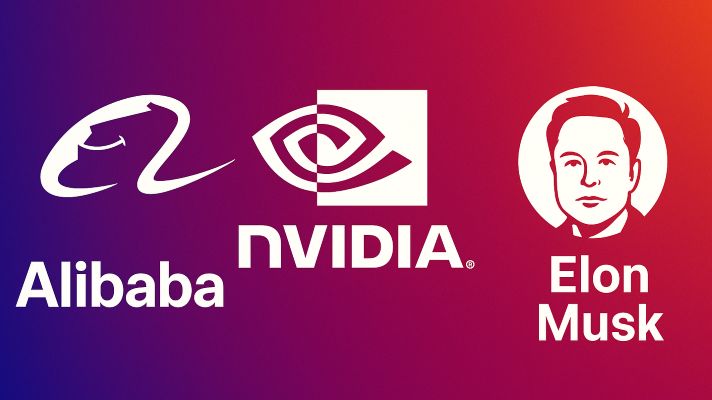AI Navigation
- articleAI Trends
- lightbulb_2AI Tips
- assistant_navigationAI Navigation
- heatHot Articles
- emergency_heat_2Hot Tips
- format_list_numberedPrompt Formatter
- psychologyTest Center(RPI)
November 17, 2025 · 24-Hour AI Briefing: Alibaba’s “Qianwen” Takes On ChatGPT, NVIDIA Stumbles With RTX 50, and Elon Musk Begins Building His Own Chips
Today’s headlines span three very different arenas — consumer AI competition, collapsing GPU product strategy, and the birth of a new vertically integrated chip ecosystem.
Alibaba is going after ChatGPT on the consumer front, NVIDIA is pushing back its RTX 50 refresh after a disappointing debut, and Elon Musk is no longer just complaining about GPU prices — he’s trying to replace the supply chain itself.

Alibaba’s “Qianwen” Enters the Consumer AI Arena — A Direct Challenge to ChatGPT
Alibaba officially launched its consumer-facing AI app “Qianwen,” built on its open-source Qwen3 model.
The app immediately crashed under extremely high user traffic on day one — indicating both unexpected demand and insufficient capacity planning.
Commentary:
Instead of just licensing models to enterprises, Alibaba is now directly shipping a consumer product, making a strategic shift from “AI infrastructure provider” to “AI platform owner.”
The crash on launch day demonstrates two things: huge market interest, and Alibaba underestimating C-side concurrency.
Unlike closed-source competitors like OpenAI, Alibaba continues to pursue open-source models + commercial products, which helps it attract global developers and strengthen ecosystem influence.
But the real question remains: Can it monetize the consumer side?
Inside China, it still has to face Doubao, DeepSeek, Wenxin, and others. Outside China, it will have to fight the fully mature GPT / Gemini / Claude ecosystem.
Is this a bold breakthrough — or a high-risk gamble?
NVIDIA Postpones RTX 50 Refresh as the Lineup Underperforms
NVIDIA is delaying the desktop RTX 50 Refresh to Q3 2026, and the mobile version to early 2027.
Since release, RTX 50 has faced disappointing performance gains, unstable drivers, and lukewarm consumer reception.
Commentary:
This isn’t a “sales” problem — it’s a product problem.
RTX 50 offers too little improvement over the 40-series to justify upgrades, especially for 4080/4090 owners.
More importantly, it signals something deeper: NVIDIA is no longer prioritizing consumer GPUs.
Its capacity, investment, and focus are shifting overwhelmingly toward data center and AI compute products (H-series, GB-series).
So, why delay?
Strategic repositioning? Supply issues? Driver immaturity? Or simply a market that no longer wants incremental GPUs?
In the AI-first era, the RTX brand may be losing internal priority — and NVIDIA doesn’t seem worried about that.
Elon Musk Starts Building His Own Chips — Full Supply Chain in the U.S.
Musk is accelerating his chip independence plan, aiming to build a complete domestic chip manufacturing chain in the U.S.
A PCB facility in Texas is already running, and a FOPLP packaging plant is scheduled to begin small-scale production in Q3 2026.
Commentary:
This is not just about costs — it’s about power.
Tesla FSD, Optimus robots, and xAI’s Grok models all depend on high-end chips.
Relying on NVIDIA + TSMC means high costs, unpredictable allocation, and external control over strategic timelines.
So Musk is doing what Musk always does: re-building the stack from scratch.
He already makes his own cars, batteries, factories — now he wants to make his own chips.
But chipmaking is not electric vehicles — it requires talent pipelines, advanced EDA tools, supply chain maturity, and painful yield learning curves.
So the big question is: Can Musk truly break the NVIDIA + TSMC dominance?
For more breaking AI news, industry insights and trend analysis, visit:
🔗 https://iaiseek.com/en
Want to catch up on major AI stories from the past 72 hours?
📎 November 15 · Apple’s Operations Legend Retires, Musk Denies $15B GPU Rumor, and YouTube Rebuilds Alliance With Disney